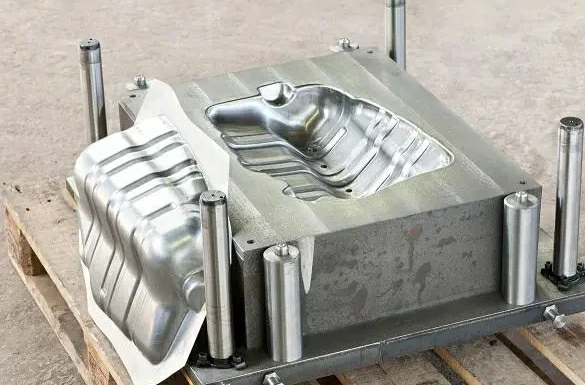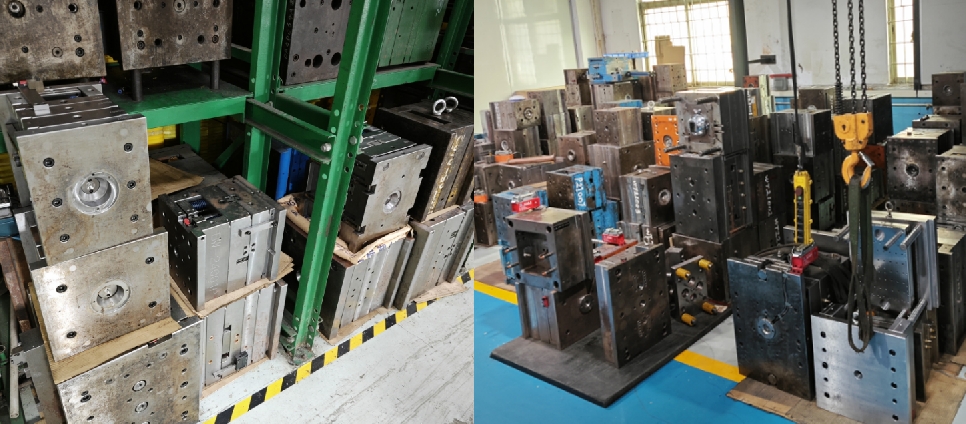In manufacturing, tools encompass a wide range of devices for cutting, forming, or molding metals. Dies are a specific subset of tools used to precisely alter the shape of metal, typically as female components in presses. Similar to molds, dies are typically tailored to the specific item they are intended to produce.
The range of products crafted with dies varies from basic items like paper clips to intricate components used in cutting-edge technology. In certain industries, such as automotive manufacturing, continuous-feed laser cutting may gradually replace traditional die-based processes.

Understanding Die Tool
Tooling Type
| Tooling Type | Description |
|---|---|
| Die Spotting Press | Hydraulic press machines for mold assembly, adjustment, and inspection. Ensures dimensional accuracy and quality in mold creation for various applications. |
| Milling | Rotates cutting blades for machining irregular and flat surfaces in metal, plastic, and wood. Performs cutting, carving, drilling, and slotting tasks with precision. |
| Gun Drilling | Specialized deep hole drilling technique using long, thin cutting instruments with high-pressure coolant. Ideal for drilling deep holes in metal workpieces. |
| Turning | Molds workpieces into different shapes by rotating them while a cutting tool moves parallel to the axis. Known for tight tolerances and high surface finishes. |
| Surface Grinder | Utilizes abrasive cutting wheels to remove metal fragments and achieve high-quality surface finishes. Commonly used for precision surface finishing on hard materials. |
| CNC Machine | Manages cutting, drilling, and grinding operations on metal workpieces using specified software and hardware. Various types cater to different machining needs. |
| EDM Machine | Precise metal removal process using electrical current between electrodes. Vital for producing tools, dies, metal stamping dies, and plastic molds. |
Die Type
| Die Type | Description |
|---|---|
| Cutting Dies | Cutting dies remove, shear, or cut material from the stock. Regardless of the mechanism used, any die involved in material removal is classified as a cutting die. Forming Dies |
| Simple Dies | Simple dies perform a single cutting or forming action per stroke. While effective for straightforward designs, they are less efficient for tasks requiring multiple forming actions. |
| Compound Dies | Compound dies execute multiple cutting and forming actions in a single stroke. Although this may slow down the stroke, compound dies prove more efficient over the entire tool manufacturing process, reducing errors in workpiece transfer between stations. |
| Progressive Dies | Progressive dies are highly efficient for accomplishing multiple operations on a single blank. Operations occur at separate stations as a feeding mechanism continuously pushes metal into the die. Each stroke initiates various cutting or forming actions on different segments of the workpiece. |
| Transfer Dies | Transfer dies resemble progressive dies but start with pre-cut blanks mechanically transferred between stations. This method, often using conveyor belts or transfer fingers, enhances efficiency, particularly for larger or complex parts unsuitable for progressive die cutting. |
| Multiple Dies | Multiple die presses, also known as gang presses, produce multiple components with each press stroke. Several identical dies are linked to the same control mechanism, enabling synchronous operation. |
Key Components of a Die
| Component | Description |
|---|---|
| Die Block | Comparable to a mold, the die block features holes and indentations corresponding to the desired component shape, achieved as the punch depresses the workpiece. |
| Punch | Male portion of the die, punching through the sheet metal into the corresponding female section of the die block. Different types include Blanking and Pierce punches. |
| Stock Guide | Ensures consistent entry position of the material within the die, maintaining uniformity in the manufacturing process. |
| Stripper Plate | Spring-loaded plate stripping the workpiece from the withdrawing punch after each press stroke. |
| Setting Block | Controls the depth to which the punch penetrates into the die, allowing for precise adjustments and quality control. |
| Guide Pins | Pins paired with guide bushings, ensuring precise alignment of die shoes during each press stroke, facilitating accurate operations. |
| Die Holder | Supports the die block and is in turn supported by a bolster plate, typically attached to the upper or lower die shoe. |
| Pilot | Assists in accurately placing the sheet for the next stage of the operation, ensuring precision and consistency. |
| Die Set | Includes the die block and punch plate. The arrangement may vary depending on the operation, such as the use of a knock-out mechanism. |
| Punch Plate | Attaches the actual punching component to the ram, facilitating movement during operation. |
| Shank | Facilitates punch plate installation onto the press, ensuring proper alignment and positioning for optimized performance. |
| Pressure Plates/Backing | Various plates distributed within the die to handle extreme pressure from the punch. |
Die Stamping
Die stamping encompasses various operations such as blanking, piercing, and bending, carried out using specialized dies in a press. Here’s an overview of the processes involved:
- Blanking: Blanking is a die cutting operation where a piece of sheet metal is cut to create a flat shape, often the desired shape of the final product. This process produces precise outlines with clean edges.
- Piercing: Piercing involves cutting holes or shapes into the sheet metal using a punch and die set. These holes can serve various purposes, such as creating openings for fasteners or ventilation.
- Bending: Bending is a die forming operation where the sheet metal is deformed to create angles, curves, or other desired shapes. This process utilizes the mechanical properties of the material to achieve the desired bend without fracturing or deforming the metal excessively.
Die forming operations, including blanking, piercing, and bending, rely on the material’s mechanical properties and the design of the dies to shape the sheet metal accurately. Tool and die makers craft the dies, which are then mounted into a press for production.
Types of Die-Cutting Processes
Die cutting, being a fabrication process, employs specialized equipment and machine tools to cut, mold, and shear stock material into unique forms and designs. Numerous die-cutting processes are accessible, including:
- Flatbed Die Cutting: Utilizes a flatbed press and is suitable for thicker materials and lower volumes.
- Rotary Die Cutting: Involves a cylindrical die on a rotary press, ideal for high-volume and high-speed applications.
- Digital Die Cutting: Uses computer-controlled tools for precise and intricate designs, eliminating the need for physical dies.
Regardless of the process, specific processing equipment must always be used following the processing requirements and die tooling procedure you select.
Uses of Die Tools in Manufacturing
Die tools play critical roles in various manufacturing processes, enabling the production of precise and consistent components. Some common uses of die tools in manufacturing include:
- Stamping: Die tools are extensively used in metal stamping processes to cut, form, or shape sheet metal into desired configurations. This includes creating components for automotive, aerospace, electronics, and appliance industries.
- Extrusion: Die tools are essential in extrusion processes where materials such as metal, plastic, or rubber are forced through a die to produce continuous shapes or profiles. This method is commonly employed in the production of pipes, tubes, and profiles.
- Injection Molding: In injection molding, die tools, also known as molds, are used to shape molten material into specific forms. This process is widely used in manufacturing plastic parts for various industries, including automotive, medical, and consumer goods. Injection molding is also divided into metal injection molding and plastic injection molding.
- Coining and Medallion Production: Die tools are employed in the minting industry to produce coins, medals, and tokens. These tools impart precise patterns and designs onto metal blanks through pressure, resulting in finished products with intricate details.
- Blanking and Piercing: Die tools are utilized in blanking and piercing operations to cut sheet metal into predetermined shapes and sizes. This process is commonly used in the production of metal components for appliances, furniture, and machinery.
- Forming and Bending: Die tools are employed in forming and bending processes to reshape sheet metal or other materials into desired contours. This includes the fabrication of automotive body panels, enclosures, and structural components.
Importance of Die Tools in Manufacturing
The importance of die tools in manufacturing cannot be overstated. They offer several advantages that enhance the overall production process:
- Precision: Die tools are engineered to extremely tight tolerances, ensuring that each part produced is identical. This level of precision is essential for components that must fit together perfectly.
- Efficiency: By automating the cutting, forming, and shaping processes, die tools significantly reduce the time and labor required to produce parts, leading to increased productivity.
- Cost-Effectiveness: Although the initial investment in die tools can be high, their ability to produce large quantities of parts with minimal waste translates to lower per-unit injection molding costs over time.
- Consistency: Die tools ensure that each part produced is consistent in quality and dimensions, which is crucial for maintaining the integrity of assemblies and final products.
- Versatility: With the ability to design and create dies for virtually any shape or material, die tools offer unparalleled versatility in manufacturing.
While traditional die-based processes are fundamental to manufacturing, advancements in technology are introducing new methods. For instance, continuous-feed laser cutting is beginning to displace traditional die-based processes in some industries, such as automotive manufacturing. This technology offers increased precision and flexibility, highlighting the ongoing evolution in manufacturing techniques.
Difference Between Tool and Die
| Aspect | Tool | Die |
|---|---|---|
| Definition | In metalworking, a tool refers to any mechanical device used to cut, form, support, or mold metals. This includes a broad range of equipment such as jigs, fixtures, drills, cutting blades, and more. Essentially, a tool encompasses any device used in metalworking processes. | A die is a specific type of tool that focuses on changing the shape of metal. It is typically a component of a larger tool or press. |
| Functionality | Tools serve various functions in metalworking, including cutting, shaping, drilling, and supporting workpieces. They can be versatile and used for multiple purposes. | Dies specifically function to change the shape of metal workpieces. They are designed for specific forming or cutting operations, often in conjunction with other die components. |
| Scope | The term “tool” is broad and encompasses a wide range of mechanical devices used in metalworking processes. It can refer to both hand tools and machine tools. | Dies are a subset of tools, focusing specifically on shaping metal workpieces. They are specialized components within the broader category of tools. |
Conclusion
Die tooling encompasses a wide range of equipment and processes tailored to the specific needs of various manufacturing applications. The choice of equipment and processes depends on factors such as material type, desired shape, production volume, and precision requirements.
If you need mold manufacturing and injection molding services, please contact BOYI. We are always available to assist you.
FAQ
A die tool is a device utilized to shape, form, or finish a material according to a desired configuration. In essence, a die tool facilitates the precise manipulation of materials to achieve predetermined shapes, forms, or finishes.
A die is commonly used to cut materials such as paper, cardboard, fabric, leather, rubber, foam, and plastic. It enables precise and identical cuts to be made repeatedly, making it ideal for applications in industries like printing, packaging, textiles, and manufacturing.
Catalog: Injection Molding Guide

This article was written by engineers from the BOYI team. Fuquan Chen is a professional engineer and technical expert with 20 years of experience in rapid prototyping, mold manufacturing, and plastic injection molding.




